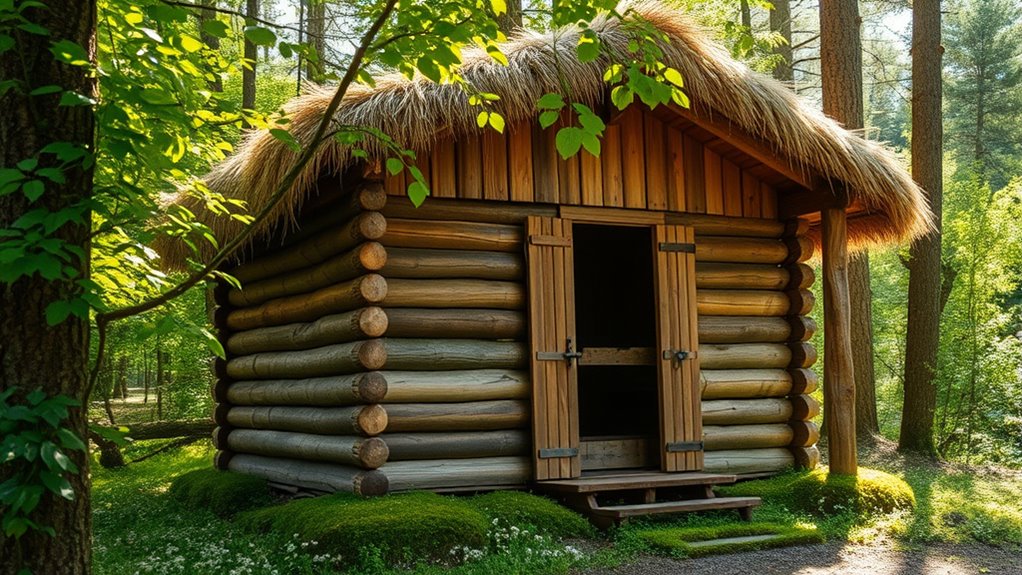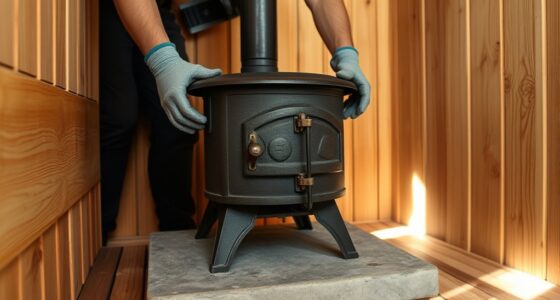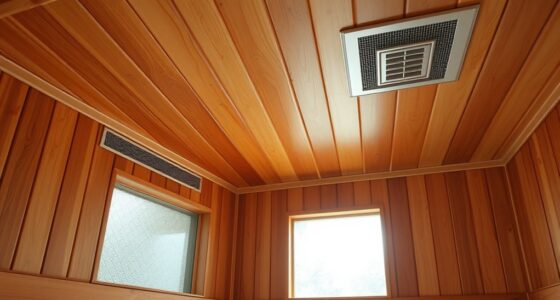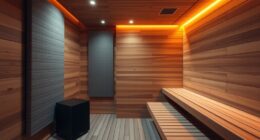Building a sauna with natural materials like thatched roofs, wood, and straw helps you create an eco-friendly, authentic retreat that merges traditional craftsmanship with sustainable design. By choosing locally sourced, renewable resources, you support environmentally conscious practices while ensuring durability and health benefits, like better indoor air quality. Incorporating handcrafted details enhances authenticity and aesthetic appeal. To learn more about how this approach combines sustainability and cultural significance, keep exploring these natural building techniques and design ideas.
Key Takeaways
- Use sustainably harvested wood and natural insulation to ensure eco-friendly, durable construction for the sauna.
- Incorporate traditional craftsmanship techniques, such as handcrafted wooden panels and thatched roofs from local reeds.
- Design with natural materials to improve indoor air quality and create a warm, inviting aesthetic.
- Employ eco-friendly principles by utilizing biodegradable, recyclable, and renewable resources throughout the build.
- Customize the sauna with natural elements to reflect cultural heritage, promote wellness, and support sustainable living.
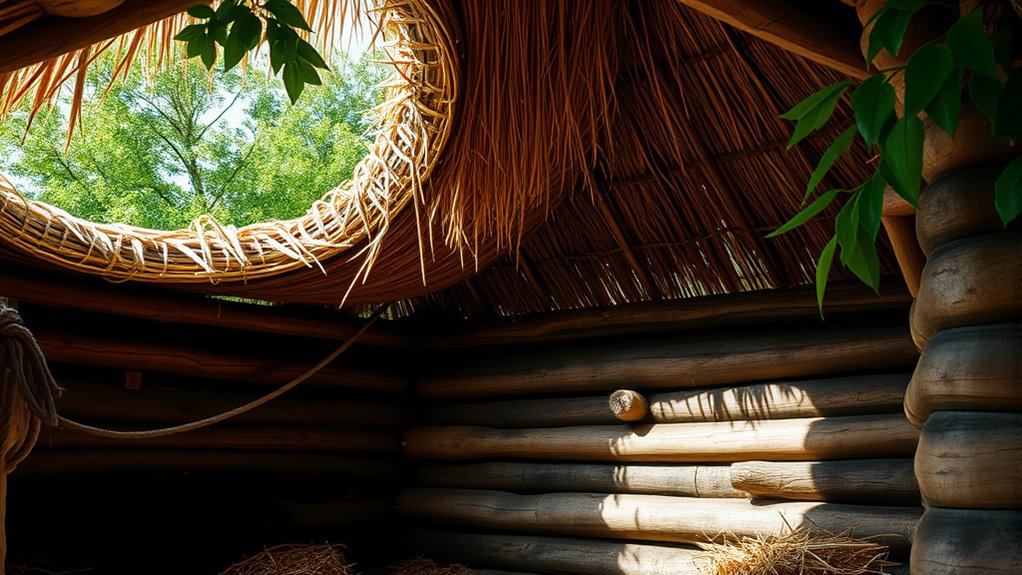
Creating a sauna with natural materials allows you to enjoy a relaxing retreat while minimizing environmental impact. When you choose to build with materials like wood, thatch, or other eco-friendly options, you’re embracing sustainable practices that benefit both you and the planet. This approach not only creates a warm, inviting space but also reflects traditional craftsmanship that has been passed down through generations. Using natural elements connects you to age-old techniques, making your sauna more than just a wellness space—it’s a piece of cultural heritage crafted with care and skill.
Opting for traditional craftsmanship means paying attention to the details that make your sauna both functional and beautiful. Skilled artisans often use locally sourced, natural materials, which help support sustainable forestry and reduce transportation emissions. These artisans understand how to work with the materials intimately, ensuring they’re used in ways that preserve their integrity and longevity. When you incorporate traditional craftsmanship into your sauna design, you’re creating a structure that’s durable, aesthetically pleasing, and infused with cultural significance. Handcrafted touches, like carefully fitted wooden panels or a thatched roof, elevate the authenticity of your retreat and guarantee that every element is made with expertise.
Eco-friendly design is at the core of building a natural sauna. By choosing renewable resources like sustainably harvested wood and natural insulation, you minimize your carbon footprint. Thatched roofs, for example, made from local reeds or straw, offer excellent insulation and a charming, rustic appearance. These materials breathe naturally, helping regulate temperature and humidity inside the sauna without relying on energy-intensive systems. When you prioritize eco-friendly design, you’re also reducing waste. Many natural materials are biodegradable or recyclable, so your sauna’s environmental impact diminishes over time. Additionally, using natural materials can improve indoor air quality by avoiding the off-gassing associated with synthetic products.
Building with natural materials also encourages a healthier indoor environment. Unlike synthetic options, natural materials don’t off-gas harmful chemicals, ensuring cleaner air inside. This is especially important in a space meant for relaxation and wellness. Furthermore, working with traditional craftsmanship means you can customize your sauna’s design to fit your preferences, blending functionality with aesthetic appeal. Whether you’re considering a thatched roof or wooden interiors, each element can be tailored to reflect your personal style while maintaining eco-conscious principles.
In the end, creating a sauna with natural materials isn’t just about aesthetics or tradition; it’s a conscious choice to live more sustainably. It’s about honoring craftsmanship that’s rooted in history while embracing modern eco-friendly practices. By doing so, you craft a sanctuary that’s both serene and responsible—an authentic retreat that benefits you and the environment alike.
Frequently Asked Questions
How Long Does a Thatched Roof Sauna Typically Last?
A thatched roof sauna typically lasts around 20 to 30 years, depending on roof durability and material longevity. You’ll need to regularly inspect and maintain the thatch, especially after harsh weather, to extend its lifespan. Proper installation and using high-quality materials help guarantee your roof stays in good shape. With good care, you can enjoy your sauna’s natural charm and functionality for decades.
What Are the Maintenance Requirements for Natural Material Saunas?
Maintaining your natural material sauna is like tending a delicate garden; it requires consistent care. You need to regularly treat the wood to prevent decay and guarantee longevity. Pest control is essential to keep unwanted critters at bay, especially in thatched roofs. Keep an eye out for mold, and clean surfaces with gentle, natural cleaners. With proper upkeep, your sauna stays beautiful, functional, and inviting for years to come.
Are There Fire Safety Concerns With Thatched Roofs?
Yes, there’s a fire hazard with thatched roofs, so you need to be cautious. The roof’s durability can be affected by weather and time, increasing fire risk if not properly maintained. To guarantee safety, you should regularly inspect and treat the thatch, keep it dry, and install fire-resistant barriers. Proper upkeep minimizes the fire hazard and helps maintain the roof’s durability, keeping your sauna safe and functional.
How Does Insulation Compare Between Natural and Modern Materials?
You’ll be amazed at how natural materials like straw and wool outperform modern insulations! They provide incredible thermal efficiency, trapping heat better than synthetic options, making your sauna cozy and energy-efficient. Plus, their environmental impact is minimal, helping you reduce your carbon footprint. While modern insulations may seem convenient, natural materials create a healthier, more sustainable space, elevating your sauna experience to a whole new level of comfort and eco-friendliness.
Can Natural Material Saunas Be Built in Humid Climates?
Yes, you can build natural material saunas in humid climates, but you must address humidity challenges carefully. Humid climate challenges can affect the durability of natural materials like thatch or wood, so choose durable, moisture-resistant options and guarantee proper ventilation. Regular maintenance is essential to prevent mold and decay. With proper design and care, natural material saunas can thrive even in humid environments.
Conclusion
Building a sauna with natural materials connects you to ancient traditions, much like crafting a timeless vessel of relaxation. By choosing thatched roofs or organic elements, you honor nature’s wisdom and create a sanctuary that’s both eco-friendly and soothing. Embrace this journey, and your sauna will become more than just a retreat—it’s a modern ode to the harmony between human craftsmanship and the natural world, inviting you to unwind and rediscover balance.
